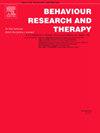Extinction, avoidance, and generalization: Fear learning processes and their relations with anxious and depressive traits
IF 4.5
2区 心理学
Q1 PSYCHOLOGY, CLINICAL
引用次数: 0
Abstract
Research shows anxious individuals exhibit slower extinction (EXT), more avoidance (AVO), and broader generalization (GEN) in Pavlovian fear conditioning, potentially contributing to maladaptive anxiety (chronic, avoidant, overgeneralized). However, studies typically focused on one of these processes, it remains unclear (1) whether the deficits in each process reflect separate or the same vulnerability factors; (2) whether deficits in any of these processes is more detrimental; (3) whether deficits in these processes cluster into distinct profiles that form an unique detrimental factor. Additionally, despite the high comorbidity rate with anxiety, the role of depression in these processes is surprisingly understudied. The current study tested EXT-AVO-GEN processes in the same individuals measuring both anxiety and depressive traits. To avoid the arbitrary selection of any indices for EXT-AVO-GEN processes, multiple index operationalizations were employed to ensure robust findings. Results showed small to no correlations, both among EXT-AVO-GEN processes and their correlations with personality characteristics. Cluster analysis identified no distinct profiles, and if such profiles were nonetheless forced to emerge, they were not associated with the anxious or depressive traits. According to these findings, EXT-AVO-GEN are likely to be independent processes and their deficits seem to have different underlying drivers. Therefore, studying EXT-AVO-GEN processes in combination may not offer additional comprehension about pathological fear development. Linear mixed-effects models, however, revealed stronger correlations between EXT-AVO-GEN and anxiety/depression, suggesting that they may be more sensitive in detecting individual differences compared to indices, as they capture trial-by-trial dynamics, which indices often fail to fully account for.
消退、回避和泛化:恐惧学习过程及其与焦虑和抑郁特征的关系
研究表明,焦虑个体在巴甫洛夫恐惧条件反射中表现出较慢的消退(EXT)、更多的回避(AVO)和更广泛的泛化(GEN),这可能导致适应不良焦虑(慢性、回避型、过度泛化)。然而,研究通常集中在这些过程中的一个,目前尚不清楚(1)每个过程中的缺陷是否反映了单独或相同的脆弱性因素;(2)这些过程中的缺陷是否更有害;(3)这些过程中的缺陷是否聚集成不同的轮廓,形成独特的有害因素。此外,尽管焦虑的合并症发生率很高,但令人惊讶的是,抑郁在这些过程中的作用尚未得到充分研究。目前的研究测试了同一个人的ext - avoo - gen过程,同时测量了焦虑和抑郁特征。为了避免任意选择EXT-AVO-GEN过程的任何指标,采用了多个指标操作化来确保稳健的结果。结果显示,EXT-AVO-GEN过程及其与人格特征的相关性很小或没有相关性。聚类分析没有发现明显的特征,即使这些特征是被迫出现的,它们也与焦虑或抑郁特征无关。根据这些发现,EXT-AVO-GEN可能是独立的过程,它们的缺陷似乎有不同的潜在驱动因素。因此,联合研究EXT-AVO-GEN过程可能无法提供对病理性恐惧发展的额外理解。然而,线性混合效应模型揭示了ext - avoo - gen与焦虑/抑郁之间更强的相关性,这表明与指数相比,它们在检测个体差异方面可能更敏感,因为它们捕获了逐个试验的动态,而指数通常无法完全解释这一点。
本文章由计算机程序翻译,如有差异,请以英文原文为准。
求助全文
约1分钟内获得全文
求助全文
来源期刊

Behaviour Research and Therapy
PSYCHOLOGY, CLINICAL-
CiteScore
7.50
自引率
7.30%
发文量
148
期刊介绍:
The major focus of Behaviour Research and Therapy is an experimental psychopathology approach to understanding emotional and behavioral disorders and their prevention and treatment, using cognitive, behavioral, and psychophysiological (including neural) methods and models. This includes laboratory-based experimental studies with healthy, at risk and subclinical individuals that inform clinical application as well as studies with clinically severe samples. The following types of submissions are encouraged: theoretical reviews of mechanisms that contribute to psychopathology and that offer new treatment targets; tests of novel, mechanistically focused psychological interventions, especially ones that include theory-driven or experimentally-derived predictors, moderators and mediators; and innovations in dissemination and implementation of evidence-based practices into clinical practice in psychology and associated fields, especially those that target underlying mechanisms or focus on novel approaches to treatment delivery. In addition to traditional psychological disorders, the scope of the journal includes behavioural medicine (e.g., chronic pain). The journal will not consider manuscripts dealing primarily with measurement, psychometric analyses, and personality assessment.
 求助内容:
求助内容: 应助结果提醒方式:
应助结果提醒方式:


